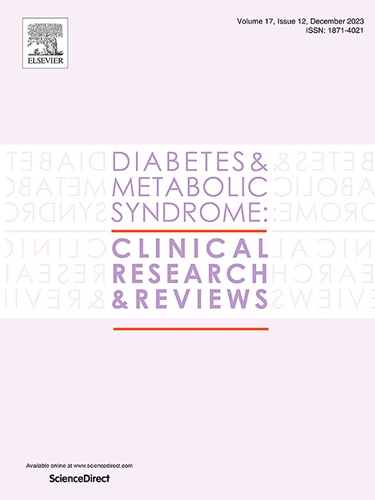定量评估 2 型糖尿病患者的代谢记忆及其对肾功能衰退的预测:回顾性观察研究
IF 3.4
Q1 ENDOCRINOLOGY & METABOLISM
Diabetes & Metabolic Syndrome-Clinical Research & Reviews
Pub Date : 2025-04-01
DOI:10.1016/j.dsx.2025.103225
引用次数: 0
摘要
目的:本研究通过模拟2型糖尿病(T2D)患者高血糖暴露与肾功能下降之间的关系,定量评估代谢记忆。方法对381例日本T2D患者进行回顾性纵向研究。通过计算观察期间HbA1c≥6% (AUCHbA1c≥6%)的曲线下面积(AUC)来表示高血糖暴露。建立非线性混合效应模型,以AUCHbA1c≥6%为基础预测肾小球滤过率(eGFR)的变化。结果AUCHbA1c≥6%与eGFR变化呈s型曲线关系,协变量包括性别、年龄、糖尿病视网膜病变、血脂异常和高血压。使用拟合优度图、视觉预测检查和自举方法验证了模型的预测效用。我们建立了一个基于AUCHbA1c≥6%的模型来预测T2D患者的肾功能下降,表明AUCHbA1c≥6%可以作为代谢记忆的定量指标。本文章由计算机程序翻译,如有差异,请以英文原文为准。
Quantitative assessment of metabolic memory and its prediction of renal function decline in patients with type 2 diabetes: A retrospective observational study
Aims
This study quantitatively assesses metabolic memory by modeling the relationship between hyperglycemic exposure and renal function decline in patients with type 2 diabetes (T2D).
Methods
This retrospective longitudinal study included 381 Japanese patients with T2D. Hyperglycemic exposure was presented by calculating the area under the curve (AUC) for HbA1c ≥ 6 % (AUCHbA1c ≥ 6 %) during the observation period. A non-linear mixed-effects model was constructed to predict changes in estimated glomerular filtration rate (eGFR) based on AUCHbA1c ≥ 6 %.
Results
The relationship between AUCHbA1c ≥ 6 % and eGFR changes was shown by a sigmoidal curve, with sex, age, diabetic retinopathy, dyslipidemia, and hypertension incorporated as covariates. The predictive utility of the model was validated using goodness-of-fit plot, visual predictive check, and bootstrap methods.
Conclusions
We developed an AUCHbA1c ≥ 6 %-based model to predict renal function decline in patients with T2D, showing that AUCHbA1c ≥ 6 % may serve as a quantitative indicator of metabolic memory.
求助全文
通过发布文献求助,成功后即可免费获取论文全文。
去求助
来源期刊

Diabetes & Metabolic Syndrome-Clinical Research & Reviews
ENDOCRINOLOGY & METABOLISM-
CiteScore
22.90
自引率
2.00%
发文量
248
审稿时长
51 days
期刊介绍:
Diabetes and Metabolic Syndrome: Clinical Research and Reviews is the official journal of DiabetesIndia. It aims to provide a global platform for healthcare professionals, diabetes educators, and other stakeholders to submit their research on diabetes care.
Types of Publications:
Diabetes and Metabolic Syndrome: Clinical Research and Reviews publishes peer-reviewed original articles, reviews, short communications, case reports, letters to the Editor, and expert comments. Reviews and mini-reviews are particularly welcomed for areas within endocrinology undergoing rapid changes.
 求助内容:
求助内容: 应助结果提醒方式:
应助结果提醒方式:


